Spatiotemporal Pattern, Evolutionary Trend, and Driving Forces Analysis of Ecological Quality in the Irtysh River Basin (2000–2020)
Abstract
1. Introduction
2. Materials and Methods
2.1. Study Area
2.2. Datasets
2.3. Methodology
2.3.1. Construction of the ARSEI
2.3.2. Time Series Stability Analysis
2.3.3. Spatiotemporal Change Detection Algorithm of the ARSEI
2.3.4. Future Trend Analysis
2.3.5. Analysis of Driving Factors
3. Results
3.1. Performance Evaluation of the ARSEI in the IRB
3.1.1. Advantages and Applicability of the ARSEI
3.1.2. Correlation Evaluation of Ecological Factors
3.2. Ecological Environment Measurement Based on the ARSEI
3.3. Time Series Analysis of Ecological Quality in the Irtysh River Basin
3.3.1. Time Series Stability Analysis
3.3.2. Pixel-Based Analysis of Spatiotemporal Changes in Ecological Quality
3.3.3. Future Trend and Persistence Analysis
3.4. Analysis of Driving Factors for Ecological Quality in the Irtysh River Basin
4. Discussion
4.1. Rationality and Superiority of the ARSEI
4.2. Spatiotemporal Pattern and Evolutionary Trend of Ecological Quality
4.3. Analysis of Driving Factors for Ecological Quality
4.4. Limitations of the Study and Future Work
5. Conclusions
Supplementary Materials
Author Contributions
Funding
Data Availability Statement
Acknowledgments
Conflicts of Interest
References
- Framing and Context. Global Warming of 1.5 °C: IPCC Special Report on Impacts of Global Warming of 1.5 °C above Pre-industrial Levels in Context of Strengthening Response to Climate Change, Sustainable Development, and Efforts to Eradicate Poverty; Intergovernmental Panel on Climate Change (IPCC), Ed.; Cambridge University Press: Cambridge, UK, 2022; pp. 49–92. ISBN 978-1-00-915795-7. [Google Scholar]
- Arias, P.A.; Bellouin, N.; Coppola, E.; Jones, R.G.; Krinner, G.; Marotzke, J.; Naik, V.; Palmer, M.D.; Plattner, G.-K.; Ro-gelj, J.; et al. 2021: Technical Summary. In Climate Change 2021: The Physical Science Basis. Contribution of Working Group I to the Sixth Assessment Report of the Intergovernmental Panel on Climate Change. Masson-Delmotte, V., Zhai, P., Pirani, A., Connors, S.L., Péan, C., Ber-ger, S., Caud, N., Chen, Y., Goldfarb, L., Gomis, M.I., et al., Eds.; Cambridge University Press: Cambridge, UK; New York, NY, USA, 2023; pp. 33–144. [Google Scholar] [CrossRef]
- Cheng, G.; Li, X. Integrated Research Methods in Watershed Science. Sci. China Earth Sci. 2015, 58, 1159–1168. [Google Scholar] [CrossRef]
- Ye, S.; Pei, L.; He, L.; Xie, L.; Zhao, G.; Yuan, H.; Ding, X.; Pei, S.; Yang, S.; Li, X.; et al. Wetlands in China: Evolution, Carbon Sequestrations and Services, Threats, and Preservation/Restoration. Water 2022, 14, 1152. [Google Scholar] [CrossRef]
- Peters, R.L.; Lovejoy, T.E. Global Warming and Biological Diversity; Yale University Press: New Haven, CT, USA, 1992; ISBN 0-300-05930-2. [Google Scholar]
- Anderson, E.P.; Marengo, J.; Villalba, R.; Halloy, S.; Young, B.; Cordero, D.; Gast, F.; Jaimes, E.; Ruiz, D.; Herzog, S.K. Consequences of Climate Change for Ecosystems and Ecosystem Services in the Tropical Andes. Clim. Chang. Biodivers. Trop. Andes 2011, 1, 1–18. [Google Scholar]
- Li, S.Y.; Lei, J.Q. The Pattern and Change of the Ecosystems in the Ergis River Watershed. Arid. Zone Res. 2002, 19, 56–61. [Google Scholar]
- Huang, W.; Duan, W.; Nover, D.; Sahu, N.; Chen, Y. An Integrated Assessment of Surface Water Dynamics in the Irtysh River Basin during 1990–2019 and Exploratory Factor Analyses. J. Hydrol. 2021, 593, 125905. [Google Scholar] [CrossRef]
- Huang, W.; Duan, W.; Chen, Y. Rapidly Declining Surface and Terrestrial Water Resources in Central Asia Driven by Socio-Economic and Climatic Changes. Sci. Total Environ. 2021, 784, 147193. [Google Scholar] [CrossRef] [PubMed]
- Stoyashcheva, N.V.; Rybkina, I.D. Water Resources of the Ob-Irtysh River Basin and Their Use. Water Resour. 2014, 41, 1–7. [Google Scholar] [CrossRef]
- Huang, F.; Xia, Z.; Li, F.; Guo, L.; Yang, F. Hydrological Changes of the Irtysh River and the Possible Causes. Water Resour. Manag. 2012, 26, 3195–3208. [Google Scholar] [CrossRef]
- Wei, Z.; Shi-chang, K.; Yong-ping, S.; Jian-qiao, H.; An-an, C. Response of Snow Hydrological Processes to a Changing Climate during 1961 to 2016 in the Headwater of Irtysh River Basin, Chinese Altai Mountains. J. Mt. Sci. 2017, 14, 2295–2310. [Google Scholar] [CrossRef]
- Liu, Q.; Wu, S. Variation Characteristics of Diurnal Temperature and Influence Factors of Irtysh River in Xinjiang. J. Soil. Water Conserv. 2017, 31, 351–356. [Google Scholar]
- Yang, Y.; Wu, X.-J.; Liu, S.-W.; Xiao, C.-D.; Wang, X. Valuating Service Loss of Snow Cover in Irtysh River Basin. Adv. Clim. Chang. Res. 2019, 10, 109–114. [Google Scholar] [CrossRef]
- Chemagin, A.A. Dynamics of Distribution of Inconnu in the Riverbeds Depression of the Irtysh River. IOP Conf. Ser. Earth Environ. Sci. 2020, 539, 012185. [Google Scholar] [CrossRef]
- Liu, Y.-J.; Wang, X.-R.; Zeng, Q.-Y. De Novo Assembly of White Poplar Genome and Genetic Diversity of White Poplar Population in Irtysh River Basin in China. Sci. China Life Sci. 2019, 62, 609–618. [Google Scholar] [CrossRef] [PubMed]
- Tusupbekov, Z.A.; Ryapolova, N.L.; Nadtochiy, V.S. Assessment of Phytocenoses Ecological Potential in South of Western Siberia Based on Hydrological and Climatic Calculations to Increase Agricultural Production. IOP Conf. Ser. Earth Environ. Sci. 2021, 624, 12235. [Google Scholar] [CrossRef]
- Xi, B.W.; Barčák, D.; Oros, M.; Chen, K.; Xie, J. The Occurrence of the Common European Fish Cestode Caryophyllaeus Laticeps (Pallas, 1781) in the River Irtysh, China: A Morphological Characterization and Molecular Data. Acta Parasitol. 2016, 61, 493–499. [Google Scholar] [CrossRef] [PubMed]
- Fan, J.; Abudumanan, A.; Wang, L.; Zhou, D.; Wang, Z.; Liu, H. Dynamic Assessment and Sustainability Strategies of Ecological Security in the Irtysh River Basin of Xinjiang, China. Chin. Geogr. Sci. 2023, 33, 393–409. [Google Scholar] [CrossRef] [PubMed]
- Yang, H.; Yang, F.; Lu, H.; Su, S. Assessment of Wetland Ecosystem Health in Irtysh River. J. Arid. Land. Resour. Environ. 2014, 28, 149–154. [Google Scholar]
- Messer, L.C.; Jagai, J.S.; Rappazzo, K.M.; Lobdell, D.T. Construction of an Environmental Quality Index for Public Health Research. Environ. Health 2014, 13, 39. [Google Scholar] [CrossRef]
- Allegro, G.; Sciaky, R. Assessing the Potential Role of Ground Beetles (Coleoptera, Carabidae) as Bioindicators in Poplar Stands, with a Newly Proposed Ecological Index (FAI). For. Ecol. Manag. 2003, 175, 275–284. [Google Scholar] [CrossRef]
- Yu, H.; Zhao, J. The Impact of Environmental Conditions on Urban Eco-Sustainable Total Factor Productivity: A Case Study of 21 Cities in Guangdong Province, China. Int. J. Environ. Res. Public Health 2020, 17, 1329. [Google Scholar] [CrossRef]
- Gandhi, G.M.; Parthiban, S.; Thummalu, N.; Christy, A. Ndvi: Vegetation Change Detection Using Remote Sensing and Gis—A Case Study of Vellore District. Procedia Comput. Sci. 2015, 57, 1199–1210. [Google Scholar] [CrossRef]
- Gao, B.C. NDWI—A Normalized Difference Water Index for Remote Sensing of Vegetation Liquid Water from Space. Remote Sens. Environ. 1996, 58, 257–266. [Google Scholar] [CrossRef]
- Xu, H. A Remote Sensing Urban Ecological Index and Its Application. Acta Ecol. Sin. 2013, 33, 7853–7862. [Google Scholar]
- Hu, X.; Xu, H. A New Remote Sensing Index Based on the Pressure-State-Response Framework to Assess Regional Ecological Change. Environ. Sci. Pollut. R 2019, 26, 5381–5393. [Google Scholar] [CrossRef] [PubMed]
- Hu, X.; Xu, H. A New Remote Sensing Index for Assessing the Spatial Heterogeneity in Urban Ecological Quality: A Case from Fuzhou City, China. Ecol. Indic. 2018, 89, 11–21. [Google Scholar] [CrossRef]
- Wang, L.; Jiao, L.; Lai, F.; Zhang, N. Evaluation of Ecological Changes Based on a Remote Sensing Ecological Index in a Manas Lake Wetland, Xinjiang. Acta Ecol. Sin. 2019, 39, 2963–2972. [Google Scholar]
- Liu, Y.; Dang, C.; Yue, H.; Lyu, C.; Qian, J.; Zhu, R. Comparison between Modified Remote Sensing Ecological Index and RSEI. Natl. Remote Sens. Bull. 2022, 26, 683–697. [Google Scholar] [CrossRef]
- Song, M.J.; Luo, Y.Y.; Duan, L.M. Evaluation of Ecological Environment in the Xilin Gol Steppe Based on Modified Remote Sensing Ecological Index Model. Arid. Zone Res. 2019, 36, 1521. [Google Scholar]
- Zhang, W.; Du, P.; Guo, S.; Lin, C.; Zheng, H.; Fu, P. Enhanced Remote Sensing Ecological Index and Ecological Environment Evaluation in Arid Area. Natl. Remote Sens. Bull. 2022, 27, 299–317. [Google Scholar] [CrossRef]
- Zhu, D.; Chen, T.; Zhen, N.; Niu, R. Monitoring the Effects of Open-Pit Mining on the Eco-Environment Using a Moving Window-Based Remote Sensing Ecological Index. Environ. Sci. Pollut. R. 2020, 27, 15716–15728. [Google Scholar] [CrossRef]
- Xu, H.; Deng, W. Rationality Analysis of MRSEl and Its Difference with RSEl. Remote Sens. Technol. Appl. 2022, 37, 1–7. [Google Scholar]
- Xu, H. A Study on Information Extraction of Water Body with the Modified Normalized Difference Water Index (MNDWI). J. Remote Sens. 2021, 5, 589–595. [Google Scholar] [CrossRef]
- Bangira, T.; Alfieri, S.M.; Menenti, M.; van Niekerk, A. Comparing Thresholding with Machine Learning Classifiers for Mapping Complex Water. Remote Sens. 2019, 11, 1351. [Google Scholar] [CrossRef]
- Tran, K.H.; Menenti, M.; Jia, L. Surface Water Mapping and Flood Monitoring in the Mekong Delta Using Sentinel-1 SAR Time Series and Otsu Threshold. Remote Sens. 2022, 14, 5721. [Google Scholar] [CrossRef]
- Li, A.; Fan, M.; Qin, G.; Xu, Y.; Wang, H. Comparative Analysis of Machine Learning Algorithms in Automatic Identification and Extraction of Water Boundaries. Appl. Sci. 2021, 11, 10062. [Google Scholar] [CrossRef]
- Tamiminia, H.; Salehi, B.; Mahdianpari, M.; Quackenbush, L.; Adeli, S.; Brisco, B. Google Earth Engine for Geo-Big Data Applications: A Meta-Analysis and Systematic Review. ISPRS J. Photogramm. Remote Sens. 2020, 164, 152–170. [Google Scholar] [CrossRef]
- Cao, B.; Yang, X.; Qiu, J. Research Progress and Application of Remote Sensing Big Data Analysis Based on Google Earth Engine. Geospat. Inf. 2021, 19, 13–19+6. [Google Scholar]
- Wang, X.; Tian, J.; Li, X.; Wang, L.; Gong, H.; Chen, B.; Li, X.; Guo, J. Benefits of Google Earth Engine in Remote Sensing. J. Remote Sens. 2022, 26, 299–309. [Google Scholar] [CrossRef]
- Yang, Z.; Tian, J.; Su, W.; Wu, J.; Liu, J.; Liu, W.; Guo, R. Analysis of Ecological Environmental Quality Change in the Yellow River Basin Using the Remote-Sensing-Based Ecological Index. Sustainability 2022, 14, 10726. [Google Scholar] [CrossRef]
- Xiong, Y.; Xu, W.; Lu, N.; Huang, S.; Wu, C.; Wang, L.; Dai, F.; Kou, W. Assessment of Spatial–Temporal Changes of Ecological Environment Quality Based on RSEI and GEE: A Case Study in Erhai Lake Basin, Yunnan Province, China. Ecol. Indic. 2021, 125, 107518. [Google Scholar] [CrossRef]
- Wang, X.; Yao, X.; Jiang, C.; Duan, W. Dynamic Monitoring and Analysis of Factors Influencing Ecological Environment Quality in Northern Anhui, China, Based on the Google Earth Engine. Sci. Rep. 2022, 12, 20307. [Google Scholar] [CrossRef] [PubMed]
- Gong, C.; Lyu, F.; Wang, Y. Spatiotemporal Change and Drivers of Ecosystem Quality in the Loess Plateau Based on RSEI: A Case Study of Shanxi, China. Ecol. Indic. 2023, 155, 111060. [Google Scholar] [CrossRef]
- Yi, S.; Zhou, Y.; Zhang, J.; Li, Q.; Liu, Y.; Guo, Y.; Chen, Y. Spatial-Temporal Evolution and Motivation of Ecological Vulnerability Based on RSEI and GEE in the Jianghan Plain from 2000 to 2020. Front. Environ. Sci. 2023, 11, 1191532. [Google Scholar] [CrossRef]
- Xu, H.; Wang, M.; Shi, T.; Guan, H.; Fang, C.; Lin, Z. Prediction of Ecological Effects of Potential Population and Impervious Surface Increases Using a Remote Sensing Based Ecological Index (RSEI). Ecol. Indic. 2018, 93, 730–740. [Google Scholar] [CrossRef]
- DeVries, B.; Verbesselt, J.; Kooistra, L.; Herold, M. Robust Monitoring of Small-Scale Forest Disturbances in a Tropical Montane Forest Using Landsat Time Series. Remote Sens. Environ. 2015, 161, 107–121. [Google Scholar] [CrossRef]
- Dewi, R.S.; Bijker, W.; Stein, A. Change Vector Analysis to Monitor the Changes in Fuzzy Shorelines. Remote Sens. 2017, 9, 147. [Google Scholar] [CrossRef]
- Zhu, Z.; Woodcock, C.E. Continuous Change Detection and Classification of Land Cover Using All Available Landsat Data. Remote Sens. Environ. 2014, 144, 152–171. [Google Scholar] [CrossRef]
- Kennedy, R.E.; Yang, Z.; Gorelick, N.; Braaten, J.; Cavalcante, L.; Cohen, W.B.; Healey, S. Implementation of the LandTrendr Algorithm on Google Earth Engine. Remote Sens. 2018, 10, 691. [Google Scholar] [CrossRef]
- Wu, S.; Gao, X.; Lei, J.; Zhou, N.; Guo, Z.; Shang, B. Ecological Environment Quality Evaluation of the Sahel Region in Africa Based on Remote Sensing Ecological Index. J. Arid. Land. 2022, 14, 14–33. [Google Scholar] [CrossRef]
- Guo, G.; Wu, Z.; Chen, Y. Evaluation of Spatially Heterogeneous Driving Forces of the Urban Heat Environment Based on a Regression Tree Model. Sustain. Cities Soc. 2020, 54, 101960. [Google Scholar] [CrossRef]
- Chen, M.; Luo, Y.; Shen, Y.; Han, Z.; Cui, Y. Driving Force Analysis of Irrigation Water Consumption Using Principal Component Regression Analysis. Agric. Water Manag. 2020, 234, 106089. [Google Scholar] [CrossRef]
- He, Y.X.; Yi, G.H.; Zhang, T.B. The EVI Trends and Driving Factors in Red River Basin Affected by the “Corridor-Corridorbarrier” Function during 2000—2014. ACTA Ecol. Sin. 2018, 38, 2056–2064. [Google Scholar]
- Wang, Z.; Liang, L.; Sun, Z.; Wang, X. Spatiotemporal Differentiation and the Factors Influencing Urbanization and Ecological Environment Synergistic Effects within the Beijing-Tianjin-Hebei Urban Agglomeration. J. Environ. Manag. 2019, 243, 227–239. [Google Scholar] [CrossRef] [PubMed]
- Geng, J.; Yu, K.; Xie, Z.; Zhao, G.; Ai, J.; Yang, L.; Yang, H.; Liu, J. Analysis of Spatiotemporal Variation and Drivers of Ecological Quality in Fuzhou Based on RSEI. Remote Sens. 2022, 14, 4900. [Google Scholar] [CrossRef]
- Zhang, Z.; Song, Y.; Wu, P. Robust Geographical Detector. Int. J. Appl. Earth Obs. Geoinf. 2022, 109, 102782. [Google Scholar] [CrossRef]
- Liang, X.; Guan, Q.; Clarke, K.C.; Liu, S.; Wang, B.; Yao, Y. Understanding the Drivers of Sustainable Land Expansion Using a Patch-Generating Land Use Simulation (PLUS) Model: A Case Study in Wuhan, China. Comput. Environ. Urban. 2021, 85, 101569. [Google Scholar] [CrossRef]
- Radelyuk, I.; Zhang, L.; Assanov, D.; Maratova, G.; Tussupova, K. A State-of-the-Art and Future Perspectives of Transboundary Rivers in the Cold Climate—A Systematic Review of Irtysh River. J. Hydrol-Reg. Stud. 2022, 42, 101173. [Google Scholar] [CrossRef]
- Zhang, X.; Zhang, W.; Zhang, D. Effects of Human Activities on Carbon Storage in the Irtysh River Basin. Arid. Zone Res. 2023, 40, 1333. [Google Scholar] [CrossRef]
- Huang, F.; Xia, Z.; Guo, L.; Yang, F. Effects of reservoirs on seasonal discharge of Irtysh River measured by Lepage test. Water Sci. Eng. 2014, 7, 363–372. [Google Scholar]
- Hrkal, Z.; Gadalia, A.; Rigaudiere, P. Will the River Irtysh Survive the Year 2030? Impact of Long-Term Unsuitable Land Use and Water Management of the Upper Stretch of the River Catchment (North Kazakhstan). Environ. Geol 2006, 50, 717–723. [Google Scholar] [CrossRef]
- Zhao, X.; Wang, C.; Li, S.; Hou, W.; Zhang, S.; Han, G.; Pan, D.; Wang, P.; Cheng, Y.; Liu, G. Genetic Variation and Selection of Introduced Provenances of Siberian Pine (Pinus Sibirica) in Frigid Regions of the Greater Xing’an Range, Northeast China. J. For. Res. 2014, 25, 549–556. [Google Scholar] [CrossRef]
- Timoshok, E.E.; Timoshok, E.N.; Gureyeva, I.I. Ecological and Cenotic Features of the Old-Growth Pinus Sibirica Forests in the North-Chuya Glaciation Center, Russian Altai. Ukr J Ecol 2020, 10, 291–298. [Google Scholar] [CrossRef] [PubMed]
- Mao, H.U.; Feng, C.; You-ping, C. Responses of Radial Growth of Pinus Sibirica to Climate and Hydrology in Altay, Xinjiang, China. Chinese Journal of Applied Ecology. 2021, 32, 3609. [Google Scholar] [CrossRef]
- Jinping, X. For Man and Nature: Building a Community of Life Together. Peace 2021, 2, 14–15+13. [Google Scholar] [CrossRef]
- Yamazaki, D.; Ikeshima, D.; Tawatari, R.; Yamaguchi, T.; O’Loughlin, F.; Neal, J.C.; Sampson, C.C.; Kanae, S.; Bates, P.D. A High-Accuracy Map of Global Terrain Elevations. Geophys. Res. Lett. 2017, 44, 5844–5853. [Google Scholar] [CrossRef]
- Copernicus Climate Change Service ERA5 Monthly Averaged Data on Single Levels from 1979 to Present 2019. Available online: https://cds.climate.copernicus.eu/cdsapp#!/dataset/reanalysis-era5-single-levels-monthly-means?tab=overview (accessed on 25 October 2023).
- Hengl, T.; Mendes de Jesus, J.; Heuvelink, G.B.; Ruiperez Gonzalez, M.; Kilibarda, M.; Blagotić, A.; Shangguan, W.; Wright, M.N.; Geng, X.; Bauer-Marschallinger, B. SoilGrids250m: Global Gridded Soil Information Based on Machine Learning. PLoS ONE 2017, 12, e0169748. [Google Scholar] [CrossRef] [PubMed]
- Center for International Earth Science Information Network—CIESIN—Columbia University Gridded Population of the World, Version 4 (GPWv4): Population Density Adjusted to Match 2015 Revision UN WPP Country Totals, Revision 11 2018. Available online: https://sedac.ciesin.columbia.edu/data/set/gpw-v4-population-density-adjusted-to-2015-unwpp-country-totals-rev11 (accessed on 25 October 2023).
- Wang, Z.; Liu, C.; Alfredo, H. From AVHRR-NDVI to MODIS-EVI: Advances in Vegetation Index Research. Acta Ecol. Sin. 2003, 23, 979–987. [Google Scholar]
- Jiao, Z.; Sun, G.; Zhang, A.; Jia, X.; Huang, H.; Yao, Y. Water Benefit-Based Ecological Index for Urban Ecological Environment Quality Assessments. IEEE J. Sel. Top. Appl. Earth Obs. Remote Sens. 2021, 14, 7557–7569. [Google Scholar] [CrossRef]
- Yosboonruang, N.; Niwitpong, S.-A.; Niwitpong, S. Bayesian Computation for the Common Coefficient of Variation of Delta-Lognormal Distributions with Application to Common Rainfall Dispersion in Thailand. Peerj 2022, 10, e12858. [Google Scholar] [CrossRef]
- Kelley, K. Sample Size Planning for the Coefficient of Variation from the Accuracy in Parameter Estimation Approach. Behav. Res. Methods 2007, 39, 755–766. [Google Scholar] [CrossRef]
- Hong, C.; Jin, X.; Ren, J.; Gu, Z.; Zhou, Y. Satellite Data Indicates Multidimensional Variation of Agricultural Production in Land Consolidation Area. Sci. Total Environ. 2019, 653, 735–747. [Google Scholar] [CrossRef] [PubMed]
- Han, F.; Yan, J.; Ling, H. Variance of Vegetation Coverage and Its Sensitivity to Climatic Factors in the Irtysh River Basin. Peerj 2021, 9, e11334. [Google Scholar] [CrossRef]
- Yao, J.; Chen, Y.; Chen, J.; Zhao, Y.; Tuoliewubieke, D.; Li, J.; Yang, L.; Mao, W. Intensification of Extreme Precipitation in Arid Central Asia. J. Hydrol. 2021, 598, 125760. [Google Scholar] [CrossRef]
- Qi, S.; Chen, S.; Long, X.; An, X.; Zhang, M. Quantitative Contribution of Climate Change and Anthropological Activities to Vegetation Carbon Storage in the Dongting Lake Basin in the Last Two Decades. Adv. Space Res. 2023, 71, 845–868. [Google Scholar] [CrossRef]
- Wang, N.; Yu, J.; Zhu, L.; Wang, Y.; He, Z. Spatial Downscaling of Remote Sensing Precipitation Data in the Beijing-Tianjin-Hebei Region. J. Comput. Commun. 2021, 9, 191–202. [Google Scholar] [CrossRef]
- Tong, S.; Zhang, J.; Bao, Y.; Lai, Q.; Lian, X.; Li, N.; Bao, Y. Analyzing Vegetation Dynamic Trend on the Mongolian Plateau Based on the Hurst Exponent and Influencing Factors from 1982–2013. J. Geogr. Sci. 2018, 28, 595–610. [Google Scholar] [CrossRef]
- Tong, S.; Lai, Q.; Zhang, J.; Bao, Y.; Lusi, A.; Ma, Q.; Li, X.; Zhang, F. Spatiotemporal Drought Variability on the Mongolian Plateau from 1980–2014 Based on the SPEI-PM, Intensity Analysis and Hurst Exponent. Sci. Total Environ. 2018, 615, 1557–1565. [Google Scholar] [CrossRef] [PubMed]
- 83. Landsat Surface Reflectance Data, Version 1: Originally Posted April 20, 2015; Version 1.1: June 16, 2015; Version 1.1 Updated: March 27, 2019; Fact Sheet; U.S. Geological Survey Reston: Reston, VA, USA, 2015; p. 1.
- NASA/METI/AIST/Japan Spacesystems, and U.A.S.T. ASTER Global Digital Elevation Model V003. distributed by NASA EOSDIS Land Processes DAAC 2019. Available online: https://data.nasa.gov/dataset/ASTER-Global-Water-Bodies-Database-V001/iric-yb28/data?no_mobile=true (accessed on 25 October 2023).
- Xu, H.; Li, C.; Lin, M. Should RSEI Use PCA or kPCA? Geomat. Inf. Sci. Wuhan Univ. 2022, 48, 506–513. [Google Scholar]
- Aldangorovna, K.B. About the Problems of Ecology of Pavlodar Region. Interact. Sci. 2018, 67–69. [Google Scholar] [CrossRef]
- Dahl, C.; Kuralbayeva, K. Energy and the Environment in Kazakhstan. Energy Policy 2001, 29, 429–440. [Google Scholar] [CrossRef]
- Yan, H.; Lai, C.; Akshalov, K.; Qin, Y.; Hu, Y.; Zhen, L. Social Institution Changes and Their Ecological Impacts in Kazakhstan over the Past Hundred Years. Environ. Dev. 2020, 34, 100531. [Google Scholar] [CrossRef]
- Kraemer, R.; Prishchepov, A.V.; Müller, D.; Kuemmerle, T.; Radeloff, V.C.; Dara, A.; Terekhov, A.; Frühauf, M. Long-Term Agricultural Land-Cover Change and Potential for Cropland Expansion in the Former Virgin Lands Area of Kazakhstan. Environ. Res. Lett. 2015, 10, 054012. [Google Scholar] [CrossRef]
- Plyusnin, V. Ecological Safety of Siberia. Contemp. Probl. Ecol. 2014, 7, 597–603. [Google Scholar] [CrossRef]
- Zheleznova, I.; Gushchina, D.; Meiramov, Z.; Olchev, A. Temporal and Spatial Variability of Dryness Conditions in Kazakhstan during 1979–2021 Based on Reanalysis Data. Climate 2022, 10, 144. [Google Scholar] [CrossRef]
- Fan, B.; Luo, G.; Hu, Z.; Li, C.-f.; Han, Q.-f.; Wang, Y.-g.; Li, X.; Yan, Y. Land Resource Development and Utilization in Central Asia. Arid. Land. Geogr. 2012, 35, 928–937. [Google Scholar]
- Issanova, G.; Abuduwaili, J.; Long, M. Overview of Central Asian Environments; China Meteorogical Press: Beijing, China, 2015; pp. 18–60. ISBN 978-7-5029-6148-0. [Google Scholar]
- Krasnoyarova, B.A.; Orlova, I.V.; Plutalova, T.G.; Sharabarina, S.N. Landscape-Ecological Assessment of Dry Lands of the Russian-Kazakhstan Border Zone for Sustainable Land Use. Arid. Ecosyst. 2019, 9, 150–156. [Google Scholar] [CrossRef]
- Palpurina, S.; Wagner, V.; von Wehrden, H.; Hájek, M.; Horsák, M.; Brinkert, A.; Hölzel, N.; Wesche, K.; Kamp, J.; Hájková, P.; et al. The Relationship between Plant Species Richness and Soil pH Vanishes with Increasing Aridity across Eurasian Dry Grasslands. Glob. Ecol. Biogeogr. 2017, 26, 425–434. [Google Scholar] [CrossRef]
- Huang, J.; Na, Y.; Guo, Y. Spatiotemporal Characteristics and Driving Mechanism of the Coupling Coordination Degree of Urbanization and Ecological Environment in Kazakhstan. J. Geogr. Sci. 2020, 30, 1802–1824. [Google Scholar] [CrossRef]
- Chytrý, M.; Danihelka, J.; Ermakov, N.; Hájek, M.; Hájková, P.; Kočí, M.; Kubešová, S.; Lustyk, P.; Otýpková, Z.; Popov, D.; et al. Plant Species Richness in Continental Southern Siberia: Effects of pH and Climate in the Context of the Species Pool Hypothesis. Glob. Ecol. Biogeogr. 2007, 16, 668–678. [Google Scholar] [CrossRef]
- Babkina, L.N.; Skotarenko, O.V.; Kozin, M.N. Main Implementation Criteria of the Ecology National Project in Russian Regions. IOP Conf. Ser. Earth Environ. Sci. 2021, 723, 042060. [Google Scholar] [CrossRef]
- Yang Huan; Yin Chunying; Tang Bo; Zheng Donghui; Zhao Chunzhang; Li Dandan; Liu Qing Difference in Soil pH Values between Picea Asperata and Abies Faxoniana Stands in Subalpine Regions and a Preliminary Study on Its Mechanism. Acta Ecol. Sin. 2018, 38, 5017–5026.


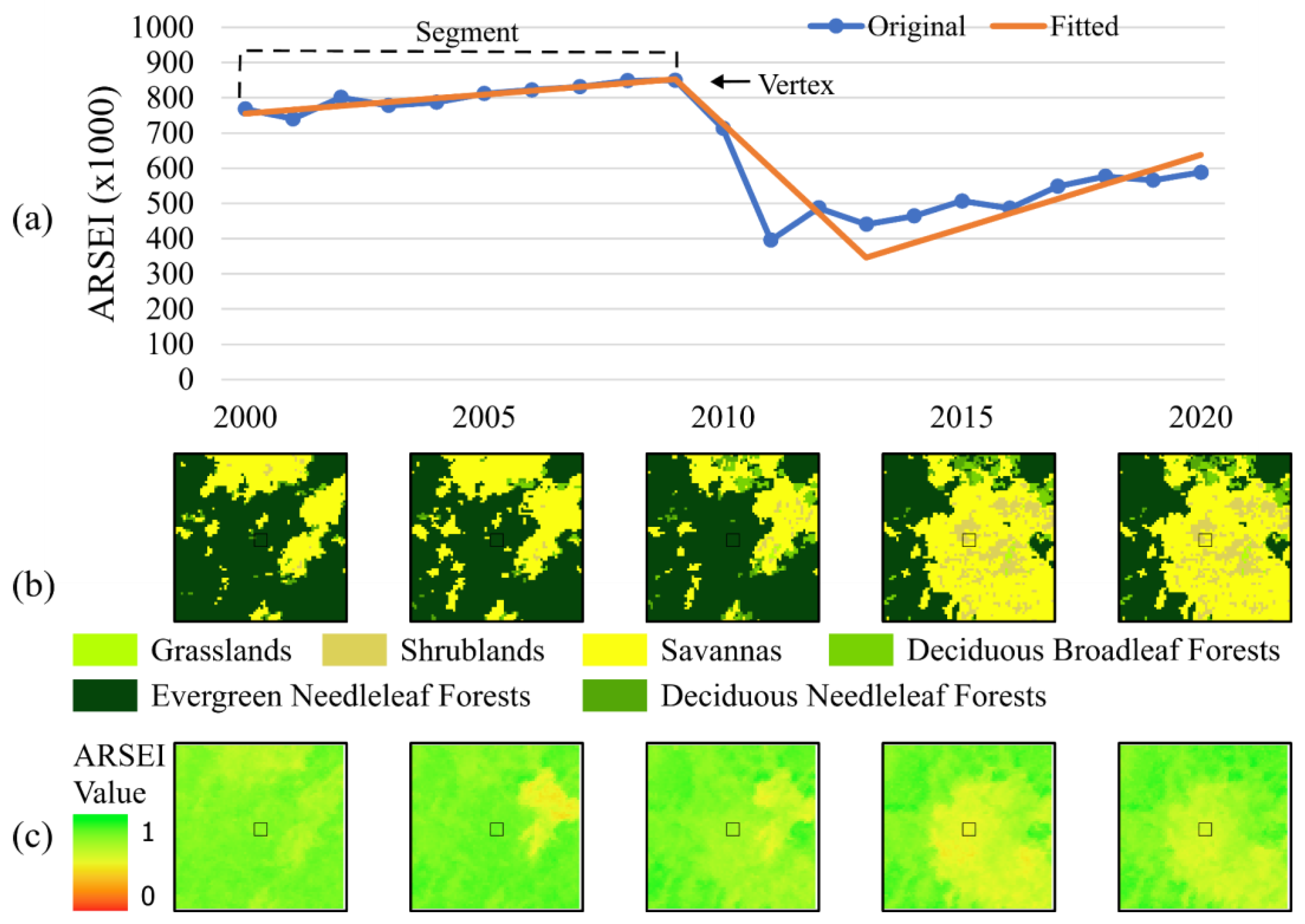
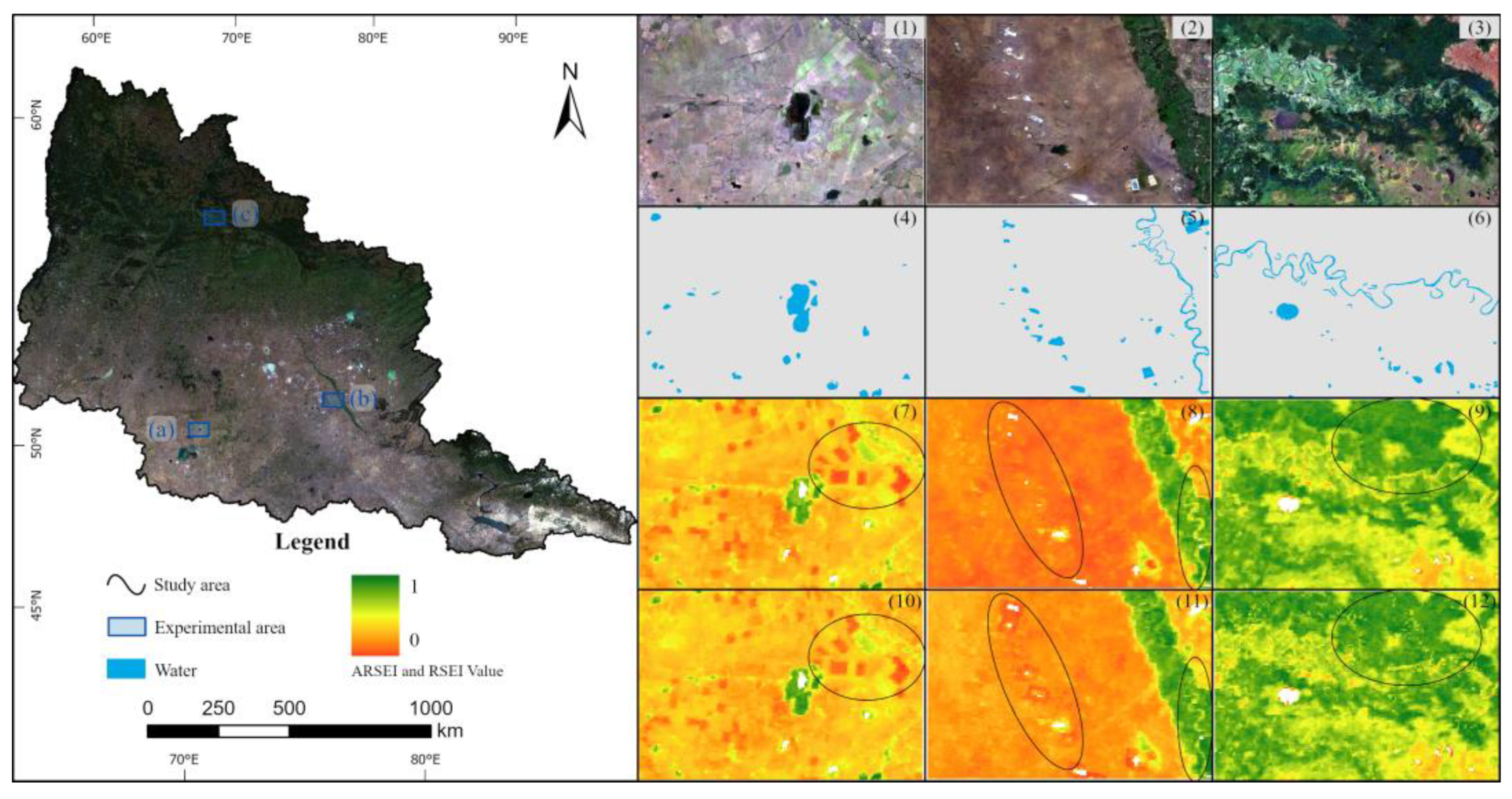

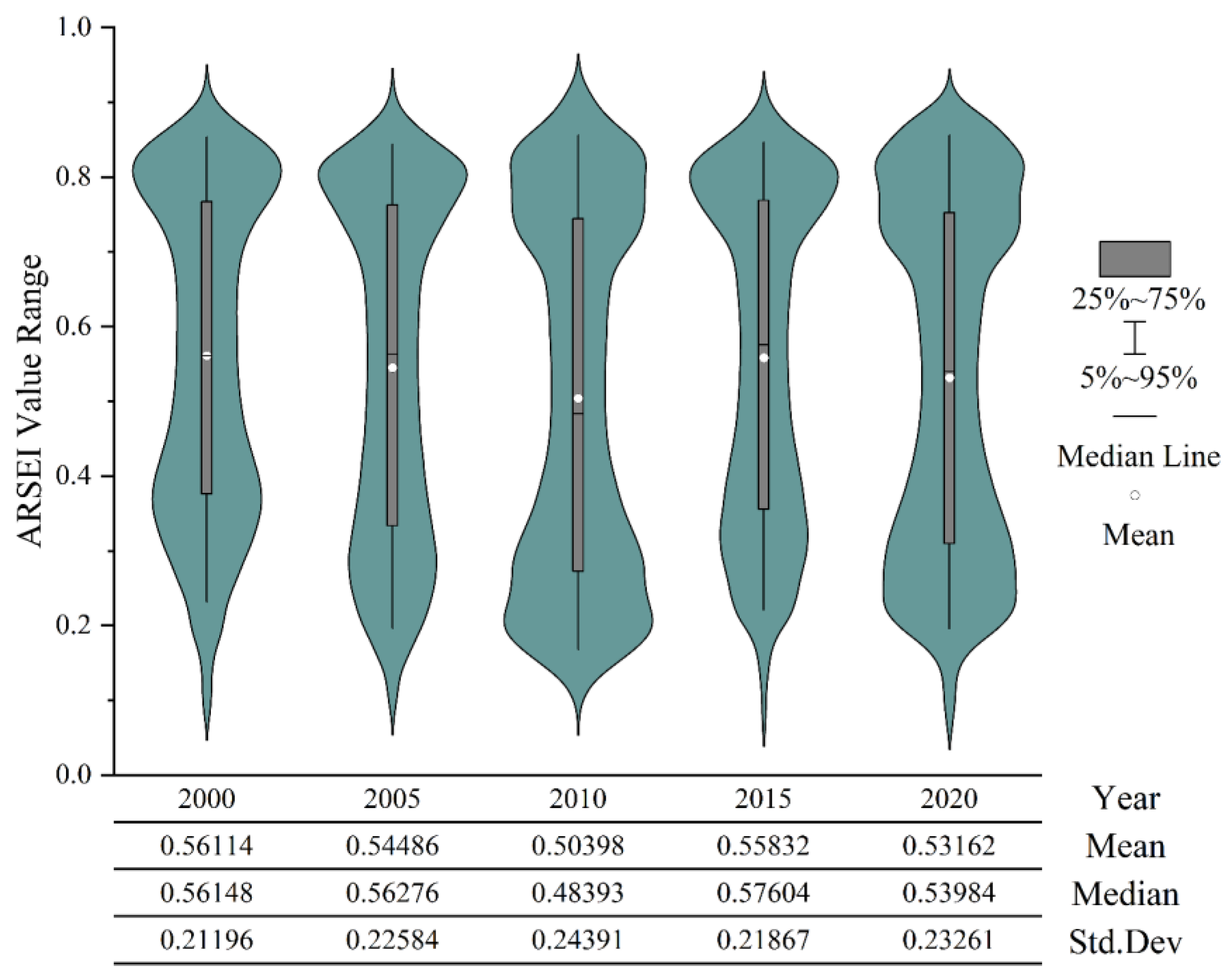

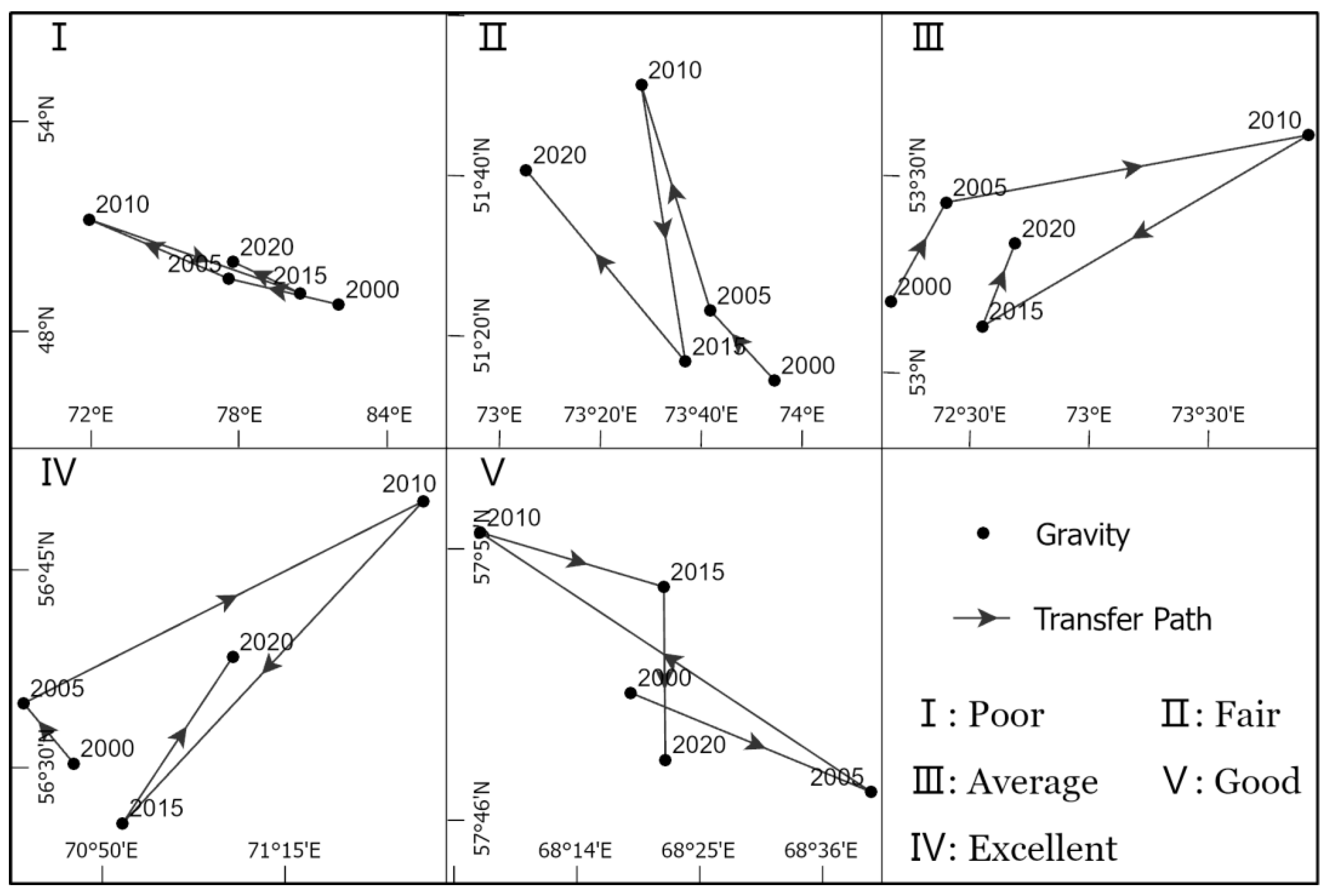
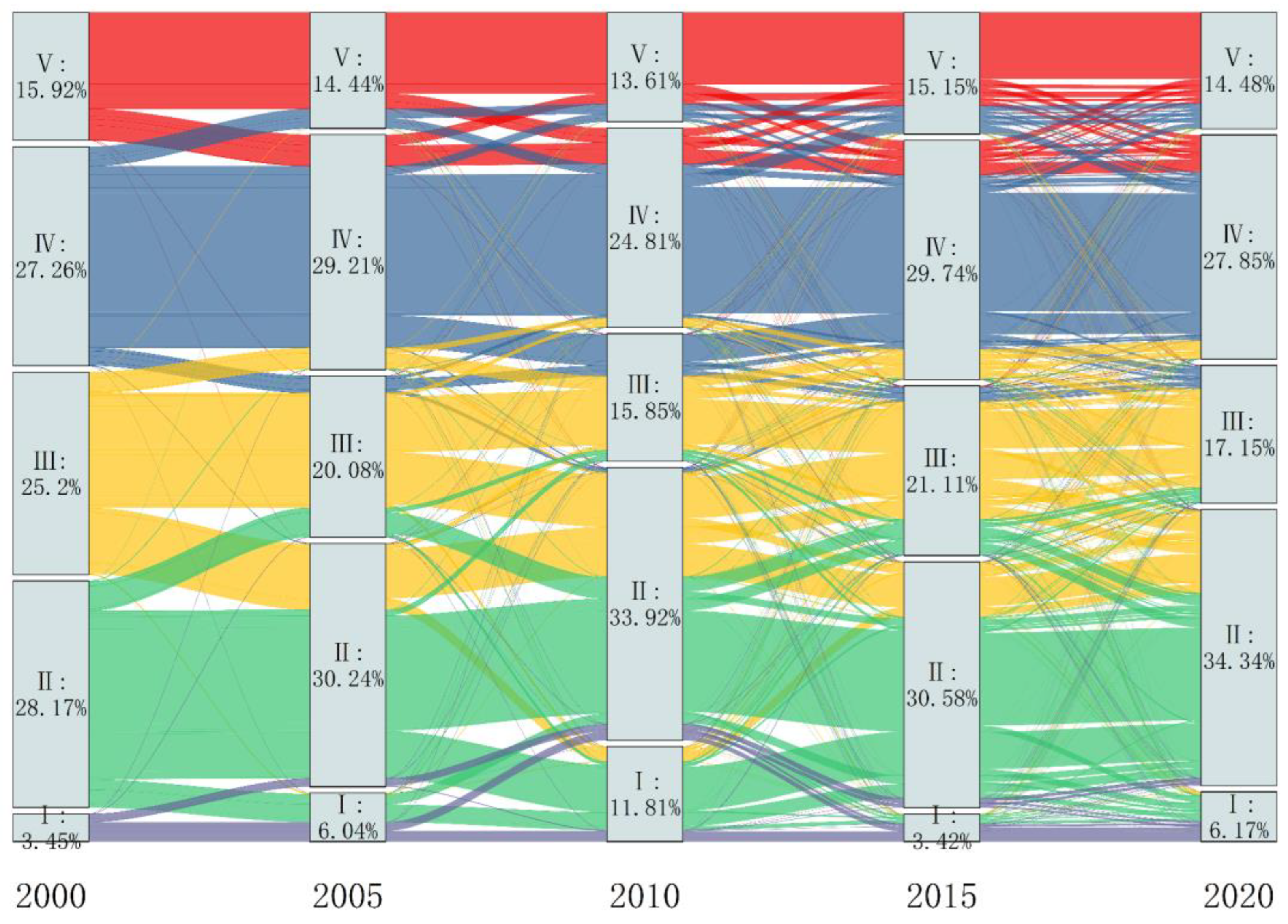

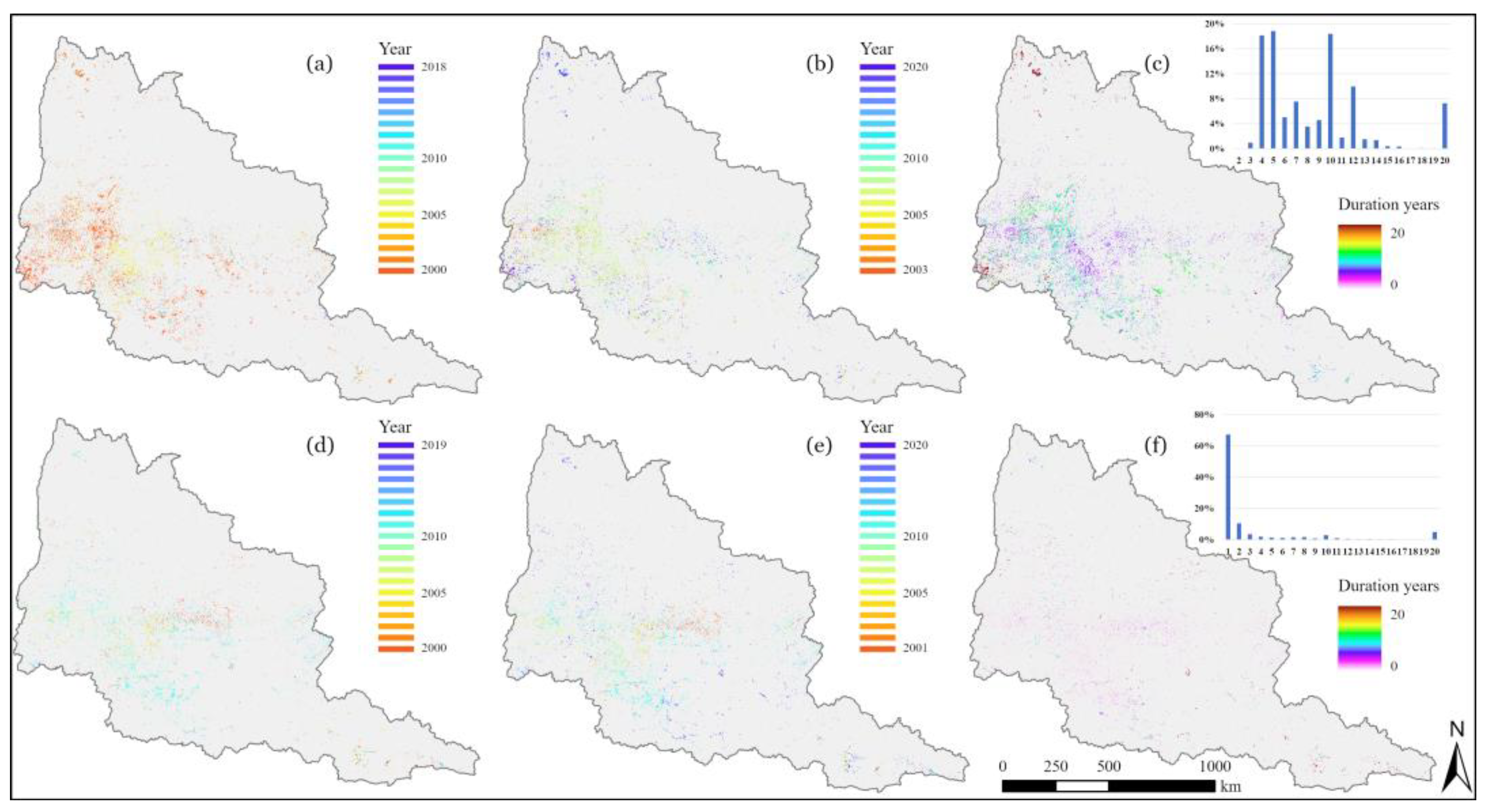
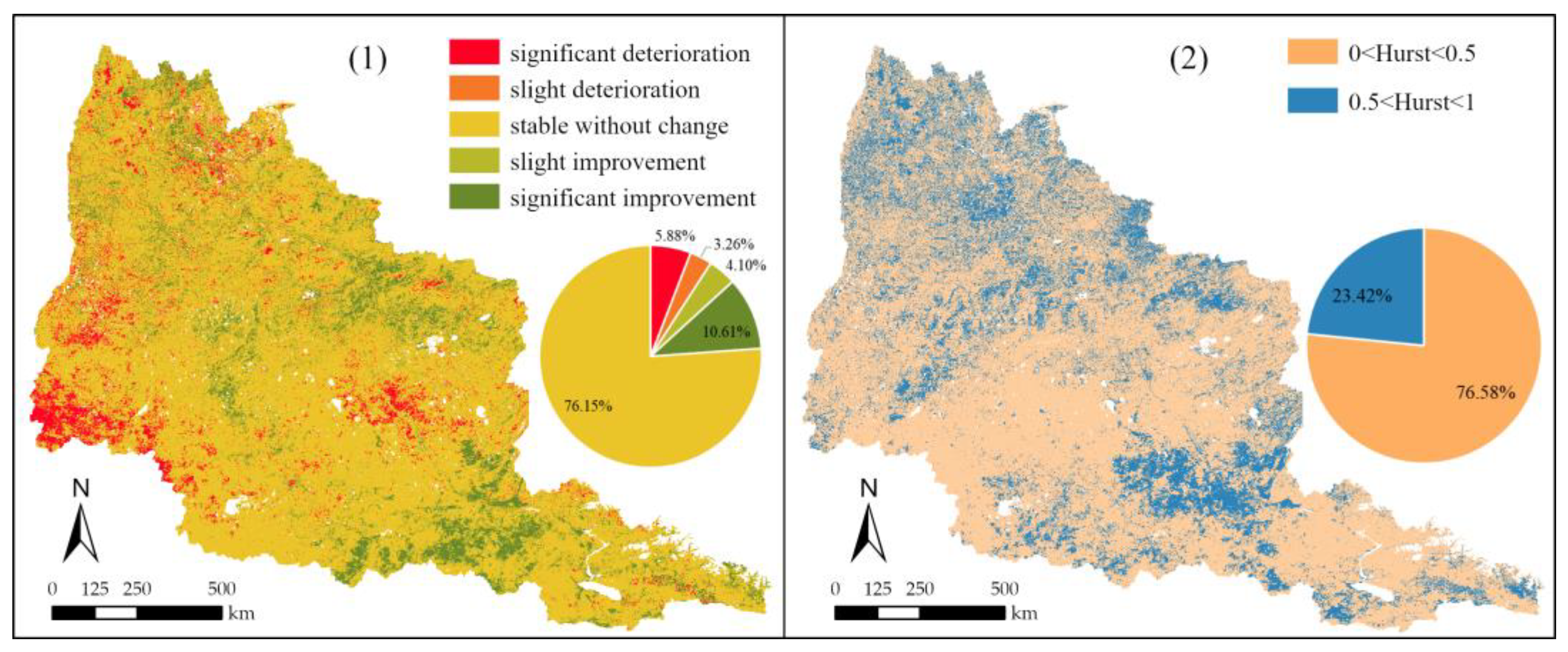

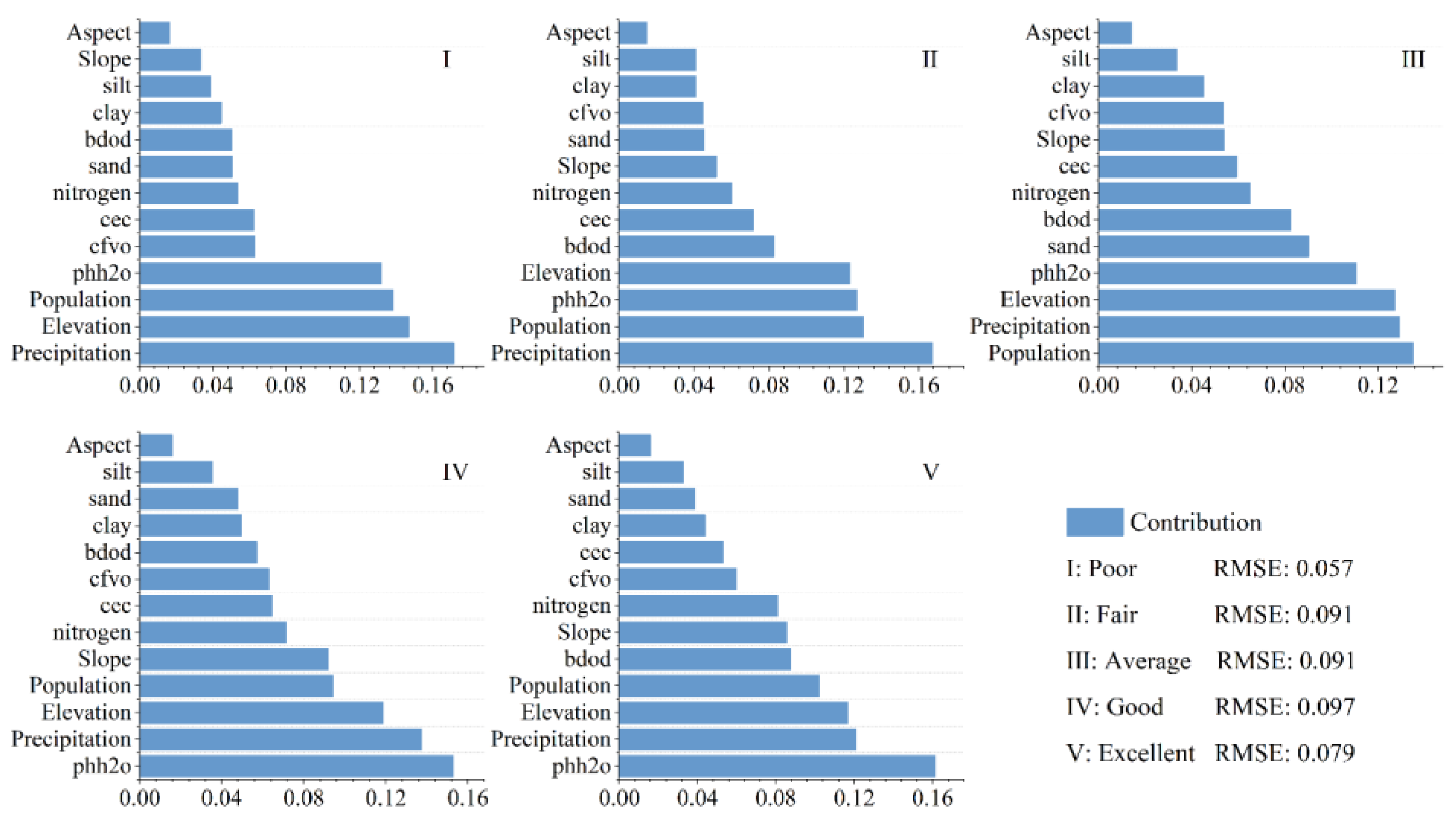
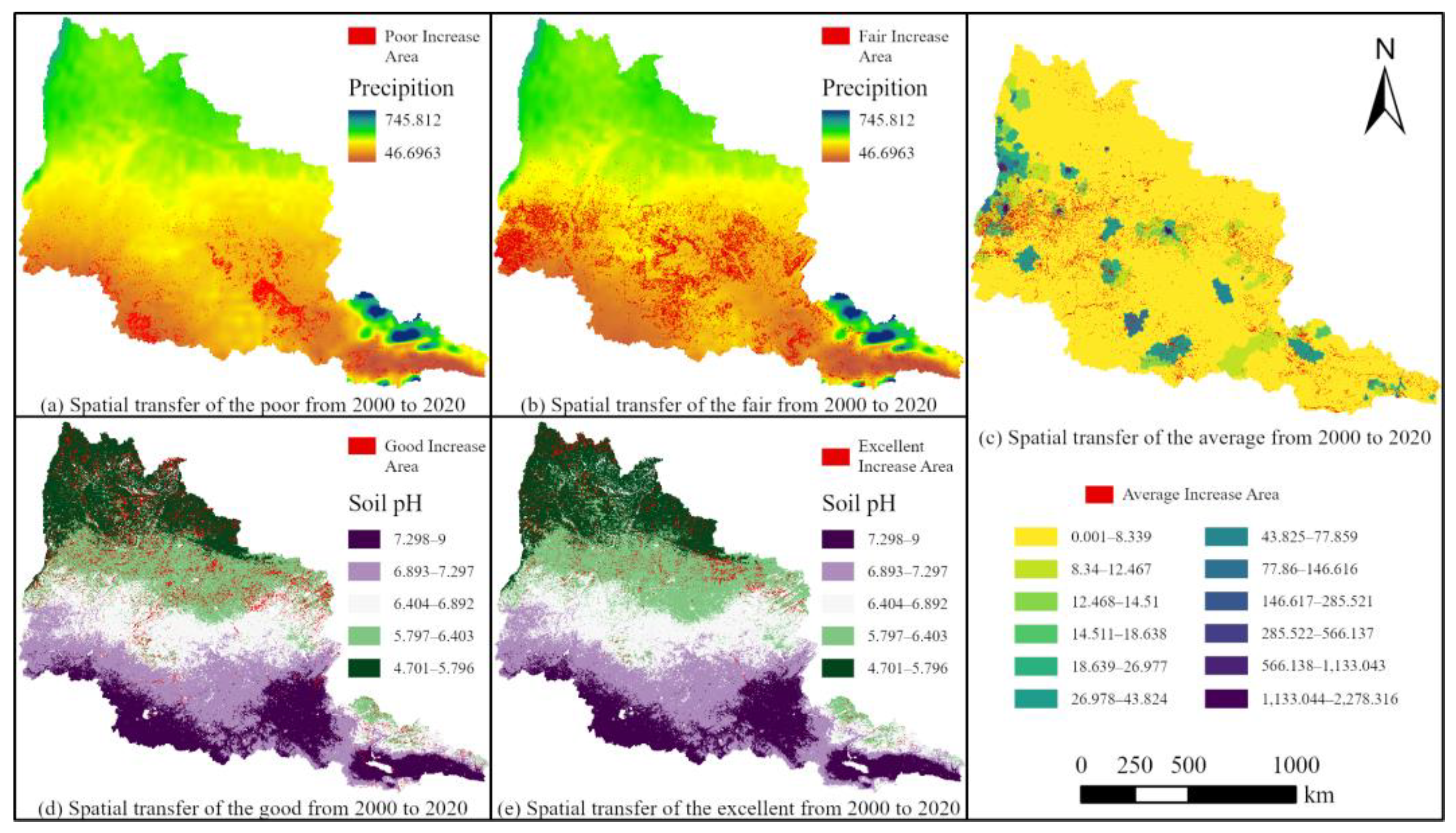
| Dataset | Time | Data Type | Spatial Resolution | Resample Method | Data Source |
|---|---|---|---|---|---|
| SPWI/CSI/NDBSI | 2000–2020 | Raster | 500 m | - | MOD09A1 Dataset (https://lpdaac.usgs.gov/products/mod09a1v061/, accessed on 1 June 2023.) |
| LST | 2000–2020 | Raster | 1000 m | bicubic | MOD11A2 Dataset (https://lpdaac.usgs.gov/products/mod11a2v061/, accessed on 1 June 2023.) |
| EVI | 2000–2020 | Raster | 250 m | bicubic | MOD13Q1 Dataset (https://lpdaac.usgs.gov/products/mod13q1v061, accessed on 1 June 2023.) |
| DEM | - | Raster | 90 m | bilinear | MERIT DEM (http://hydro.iis.u-tokyo.ac.jp/, accessed on 1 June 2023.) |
| Soil data | 2020 | Raster | 250 m | bicubic | SoilGrids250m 2.0 data (https://data.isric.org, accessed on 1 June 2023.) |
| Total precipitation | 2000–2020 | Raster | 0.1° | bicubic | Total precipitation (https://cds.climate.copernicus.eu, accessed on 1 June 2023.) |
| Population density | 2000–2020 | Raster | 1000 m | Nearest neighbor | GPW v4 (https://sedac.ciesin.columbia.edu/, accessed on 1 June 2023.) |
| ARSEI | 2000–2020 | Raster | 500 m | - | Data products for this article |
| Ecological Factor | Ecological Indicator | Calculation Method |
|---|---|---|
| Greenness | EVI | MODIS Product (MOD13Q1) |
| Humidity | SPWI | |
| Heat | LST | MODIS Product (MOD11A2) |
| Dryness | NDBSI | |
| Salinity | CSI |
| SARSEI | Z | Trend | H | Types of EQ Changes |
|---|---|---|---|---|
| SARSEI > 0 | 1.96 < Z | Significant improvement | H > 0.5 | Persistent and significant improvement |
| 1.65 < Z ≤ 1.96 | Slight improvement | Persistent and slight improvement | ||
| SARSEI < 0 | 1.96 < Z | Significant deterioration | H < 0.5 | Persistent and significant degradation → Persistent and significant improvement |
| 1.65 < Z ≤ 1.96 | Slight deterioration | Persistent and slight degradation → Persistent and slight improvement | ||
| SARSEI = 0 | 0 < Z ≤ 1.65 | Stable without change | - | Persistent and stable |
| SARSEI > 0 | 1.65 < Z ≤ 1.96 | Slight improvement | H < 0.5 | Persistent and slight improvement → Persistent and slight degradation |
| 1.96 < Z | Significant improvement | Persistent and significant improvement → Persistent and significant degradation | ||
| SARSEI < 0 | 1.65 < Z ≤ 1.96 | Slight deterioration | H > 0.5 | Persistent and slight degradation |
| 1.96 < Z | Significant deterioration | Persistent and significant degradation |
| Year | Parameters | EVI | LST | SPWI | NDBSI | CSI |
|---|---|---|---|---|---|---|
| 2000 | Water threshold | −0.0898 | ||||
| Eigenvalues | 0.1227 | 0.0073 | 0.0047 | 0.0031 | 0.0004 | |
| Percentage variance | 88.79% | 5.31% | 3.37% | 2.27% | 0.26% | |
| PC1 | 0.4346 | −0.4346 | 0.4610 | −0.4622 | −0.4428 | |
| PC2 | −0.6974 | −0.5770 | 0.2405 | −0.1680 | 0.3077 | |
| PC3 | −0.1105 | 0.6405 | 0.4869 | −0.5034 | 0.2952 | |
| PC4 | 0.5590 | −0.2563 | 0.0241 | 0.0362 | 0.7874 | |
| PC5 | −0.0110 | −0.0477 | −0.7014 | −0.7096 | 0.0464 | |
| 2005 | Water threshold | −0.0585 | ||||
| Eigenvalues | 0.1233 | 0.0081 | 0.0038 | 0.0028 | 0.0003 | |
| Percentage variance | 89.18% | 5.85% | 2.74% | 1.99% | 0.24% | |
| PC1 | 0.4322 | −0.4326 | 0.4618 | −0.4628 | −0.4456 | |
| PC2 | −0.6611 | −0.5772 | 0.2473 | −0.1844 | 0.3669 | |
| PC3 | −0.3892 | 0.6761 | 0.4086 | −0.4525 | −0.1404 | |
| PC4 | 0.4739 | 0.1436 | 0.2443 | −0.2218 | 0.8037 | |
| PC5 | 0.0101 | 0.0442 | 0.7064 | 0.7056 | −0.0338 | |
| 2010 | Water threshold | −0.0743 | ||||
| Eigenvalues | 0.1266 | 0.0062 | 0.0030 | 0.0026 | 0.0003 | |
| Percentage variance | 91.3% | 4.49% | 2.13% | 1.84% | 0.24% | |
| PC1 | 0.4399 | −0.4363 | 0.4585 | −0.4583 | −0.4426 | |
| PC2 | −0.5726 | −0.6220 | 0.2332 | −0.1613 | 0.4527 | |
| PC3 | −0.1337 | 0.6360 | 0.4637 | −0.5356 | 0.2751 | |
| PC4 | 0.6788 | −0.1176 | −0.0190 | 0.0460 | 0.7232 | |
| PC5 | −0.0093 | −0.0665 | −0.7211 | −0.6892 | 0.0228 | |
| 2015 | Water threshold | −0.0820 | ||||
| Eigenvalues | 0.1236 | 0.0081 | 0.0033 | 0.0030 | 0.0004 | |
| Percentage variance | 89.26% | 5.87% | 2.41% | 2.18% | 0.28% | |
| PC1 | 0.4300 | −0.4372 | 0.4623 | −0.4620 | −0.4436 | |
| PC2 | −0.6871 | −0.5502 | 0.2397 | −0.2142 | 0.3491 | |
| PC3 | 0.4232 | −0.6712 | −0.3542 | 0.4135 | 0.2718 | |
| PC4 | 0.4049 | 0.2329 | 0.3007 | −0.2907 | 0.7790 | |
| PC5 | 0.0083 | −0.0365 | −0.7162 | −0.6965 | 0.0231 | |
| 2020 | Water threshold | −0.0509 | ||||
| Eigenvalues | 0.1248 | 0.0074 | 0.0035 | 0.0023 | 0.0004 | |
| Percentage variance | 90.21% | 5.31% | 2.54% | 1.65% | 0.28% | |
| PC1 | 0.4400 | −0.4245 | 0.4622 | −0.4607 | −0.4476 | |
| PC2 | −0.5250 | −0.7469 | 0.1286 | −0.0564 | 0.3830 | |
| PC3 | 0.5418 | −0.4915 | −0.4397 | 0.5210 | 0.0084 | |
| PC4 | 0.4870 | 0.1249 | 0.2080 | −0.2261 | 0.8080 | |
| PC5 | −0.0015 | −0.0687 | −0.7302 | −0.6797 | 0.0093 | |
Disclaimer/Publisher’s Note: The statements, opinions and data contained in all publications are solely those of the individual author(s) and contributor(s) and not of MDPI and/or the editor(s). MDPI and/or the editor(s) disclaim responsibility for any injury to people or property resulting from any ideas, methods, instructions or products referred to in the content. |
© 2024 by the authors. Licensee MDPI, Basel, Switzerland. This article is an open access article distributed under the terms and conditions of the Creative Commons Attribution (CC BY) license (https://creativecommons.org/licenses/by/4.0/).
Share and Cite
Li, W.; Samat, A.; Abuduwaili, J.; Wang, W. Spatiotemporal Pattern, Evolutionary Trend, and Driving Forces Analysis of Ecological Quality in the Irtysh River Basin (2000–2020). Land 2024, 13, 222. https://doi.org/10.3390/land13020222
Li W, Samat A, Abuduwaili J, Wang W. Spatiotemporal Pattern, Evolutionary Trend, and Driving Forces Analysis of Ecological Quality in the Irtysh River Basin (2000–2020). Land. 2024; 13(2):222. https://doi.org/10.3390/land13020222
Chicago/Turabian StyleLi, Wenbo, Alim Samat, Jilili Abuduwaili, and Wei Wang. 2024. "Spatiotemporal Pattern, Evolutionary Trend, and Driving Forces Analysis of Ecological Quality in the Irtysh River Basin (2000–2020)" Land 13, no. 2: 222. https://doi.org/10.3390/land13020222
APA StyleLi, W., Samat, A., Abuduwaili, J., & Wang, W. (2024). Spatiotemporal Pattern, Evolutionary Trend, and Driving Forces Analysis of Ecological Quality in the Irtysh River Basin (2000–2020). Land, 13(2), 222. https://doi.org/10.3390/land13020222








